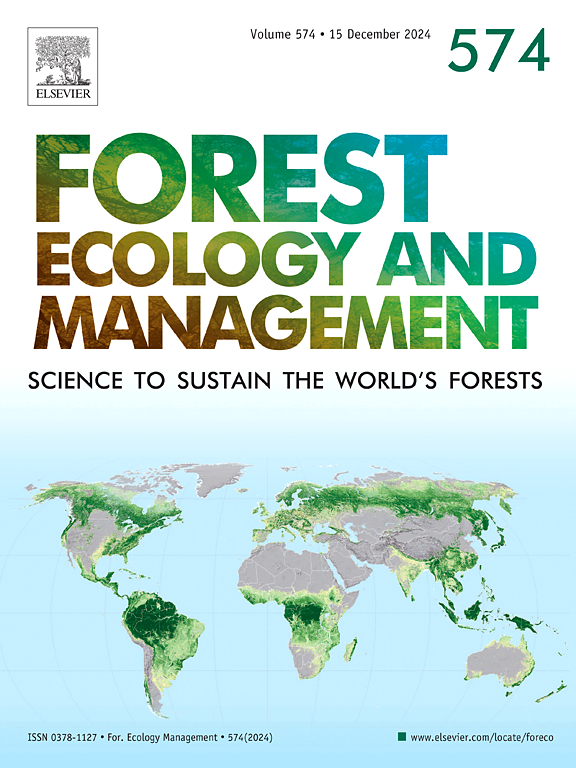近期火灾史增强了半干旱针叶林的抗旱能力
IF 3.7
2区 农林科学
Q1 FORESTRY
引用次数: 0
摘要
气候变化正在扩大野火的燃烧面积和严重程度,以及干旱引起的树木死亡(枯死)事件。气候变化的直接影响放大了野火,而干旱引起的枯死事件则对森林调节气候、提供水源和储存碳的能力产生了众所周知的影响。但人们对过去的干扰如何产生相互作用效应,从而改变随后的干扰发生率和强度了解较少,这对管理决策产生了影响,而管理决策可以促进森林的抵抗力和恢复力。我们通过将历史火灾地理空间数据库与对加利福尼亚内华达山脉森林的卫星和航空观测相结合,构建了两个平行的森林时序,以评估火灾历史对植被恢复、用水(蒸散)和干旱引起的森林衰退的影响。我们利用这些数据集来评估两个研究问题:(1)火灾历史是否会放大或减小干旱导致的枯死强度?(2.) 火灾引起的森林结构和蒸散发变化如何改变随后的森林枯死强度?我们的研究表明,与未燃烧的对照组相比,最近的火灾历史降低了干旱引起的森林枯死强度。这些受火灾影响的森林的特点是树木覆盖率降低和蒸散量减少,这两种因素结合在一起增加了森林的抗旱性,其程度超过了任何一种单独效应的预期。火灾发生二十年后,蒸散量恢复到火灾前的状况。树木和灌木覆盖率开始接近火灾前的状况,但严重程度较高的火灾除外,在这些火灾中,树木覆盖率持续下降,灌木覆盖率持续上升。基于实地的燃料处理研究表明,火灾历史也可能会提高森林的长期恢复能力。在火灾易发的针叶林中,近期低度和中度火灾的交互作用将提高抗旱性,或许还能增强森林的长期稳定性。本文章由计算机程序翻译,如有差异,请以英文原文为准。
Recent fire history enhances semi-arid conifer forest drought resistance
Climate change is amplifying both wildfire burned area and severity, as well as incidents of drought-induced tree mortality (dieback). Direct effects from climate change amplify wildfires and episodes of drought-induced dieback have well-known impacts on forest’s ability to regulate climate, provide water, and store carbon. Less understood are how past disturbances produce interaction effects that can change subsequent disturbance occurrence and intensity, with implications for management decisions that can promote forest resistance and resilience. We constructed two parallel forest chrono-sequences by combining a geospatial database of historical fire with satellite and airborne observations of forests in the Sierra Nevada of California to assess the impact of fire history on vegetation recovery, water use (evapotranspiration), and drought-induced forest dieback. We used these data sets to assess two research questions: (1.) Does fire history amplify or reduce drought-dieback intensity? (2.) What mechanisms explain how fire-induced changes to forest structure and ET alter subsequent forest dieback intensity? We show that recent fire history decreased drought-induced forest dieback intensity, compared to unburned controls. These fire-affected forests were characterized by reduced tree cover and decreased evapotranspiration, which combined to increase drought resistance more than would be expected by either effect individually. Two decades post-fire, evapotranspiration returned to pre-fire conditions. Tree and shrub cover started to approach pre-fire conditions, except for high severity fires where decreased tree cover and increased shrub cover persisted. Field based research on fuels treatments suggests that fire history may also increase longer term forest resilience. In fire-prone conifer forests, interaction effects from recent low and moderate severity fires will increase drought resistance and perhaps longer-term forest stability.
求助全文
通过发布文献求助,成功后即可免费获取论文全文。
去求助
来源期刊

Forest Ecology and Management
农林科学-林学
CiteScore
7.50
自引率
10.80%
发文量
665
审稿时长
39 days
期刊介绍:
Forest Ecology and Management publishes scientific articles linking forest ecology with forest management, focusing on the application of biological, ecological and social knowledge to the management and conservation of plantations and natural forests. The scope of the journal includes all forest ecosystems of the world.
A peer-review process ensures the quality and international interest of the manuscripts accepted for publication. The journal encourages communication between scientists in disparate fields who share a common interest in ecology and forest management, bridging the gap between research workers and forest managers.
We encourage submission of papers that will have the strongest interest and value to the Journal''s international readership. Some key features of papers with strong interest include:
1. Clear connections between the ecology and management of forests;
2. Novel ideas or approaches to important challenges in forest ecology and management;
3. Studies that address a population of interest beyond the scale of single research sites, Three key points in the design of forest experiments, Forest Ecology and Management 255 (2008) 2022-2023);
4. Review Articles on timely, important topics. Authors are welcome to contact one of the editors to discuss the suitability of a potential review manuscript.
The Journal encourages proposals for special issues examining important areas of forest ecology and management. Potential guest editors should contact any of the Editors to begin discussions about topics, potential papers, and other details.
 求助内容:
求助内容: 应助结果提醒方式:
应助结果提醒方式:


